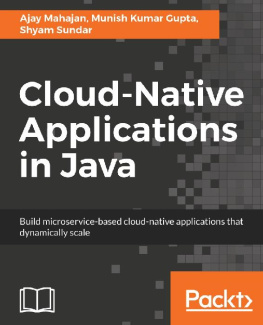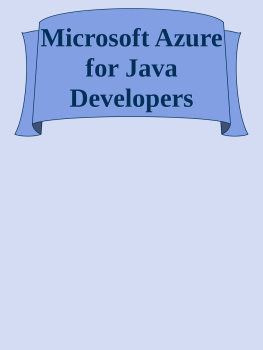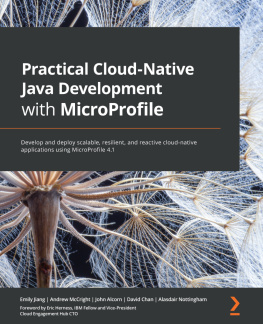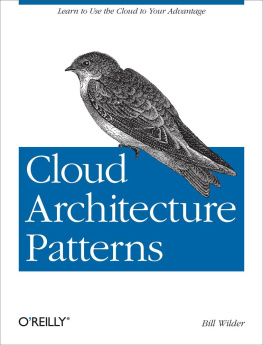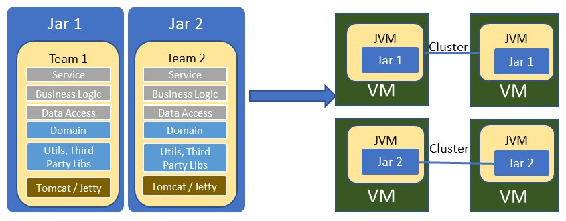Shyam Sundar - Cloud-Native Applications in Java
Here you can read online Shyam Sundar - Cloud-Native Applications in Java full text of the book (entire story) in english for free. Download pdf and epub, get meaning, cover and reviews about this ebook. year: 2018, publisher: Packt Publishing, genre: Computer. Description of the work, (preface) as well as reviews are available. Best literature library LitArk.com created for fans of good reading and offers a wide selection of genres:
Romance novel
Science fiction
Adventure
Detective
Science
History
Home and family
Prose
Art
Politics
Computer
Non-fiction
Religion
Business
Children
Humor
Choose a favorite category and find really read worthwhile books. Enjoy immersion in the world of imagination, feel the emotions of the characters or learn something new for yourself, make an fascinating discovery.
- Book:Cloud-Native Applications in Java
- Author:
- Publisher:Packt Publishing
- Genre:
- Year:2018
- Rating:5 / 5
- Favourites:Add to favourites
- Your mark:
Cloud-Native Applications in Java: summary, description and annotation
We offer to read an annotation, description, summary or preface (depends on what the author of the book "Cloud-Native Applications in Java" wrote himself). If you haven't found the necessary information about the book — write in the comments, we will try to find it.
Highly available microservice-based web apps for Cloud with Java
About This Book
- Take advantage of the simplicity of Spring to build a full-fledged application
- Let your applications run faster while generating smaller cloud service bills
- Integrate your application with various tools such as Docker and ElasticSearch and use specific tools in Azure and AWS
Who This Book Is For
Java developers who want to build secure, resilient, robust and scalable applications that are targeted for cloud based deployment, will find this book helpful. Some knowledge of Java, Spring, web programming and public cloud providers (AWS, Azure) should be sufficient to get you through the book.
What You Will Learn
- See the benefits of the cloud environment when it comes to variability, provisioning, and tooling support
- Understand the architecture patterns and considerations when developing on the cloud
- Find out how to perform cloud-native techniques/patterns for request routing, RESTful service creation, Event Sourcing, and more
- Create Docker containers for microservices and set up continuous integration using Jenkins
- Monitor and troubleshoot an application deployed in the cloud environment
- Explore tools such as Docker and Kubernetes for containerization and the ELK stack for log aggregation and visualization
- Use AWS and Azure specific tools to design, develop, deploy, and manage applications
- Migrate from monolithic architectures to a cloud native deployment
In Detail
Businesses today are evolving so rapidly that they are resorting to the elasticity of the cloud to provide a platform to build and deploy their highly scalable applications. This means developers now are faced with the challenge of building build applications that are native to the cloud. For this, they need to be aware of the environment, tools, and resources theyre coding against.
If youre a Java developer who wants to build secure, resilient, robust, and scalable applications that are targeted for cloud-based deployment, this is the book for you. It will be your one stop guide to building cloud-native applications in Java Spring that are hosted in On-prem or cloud providers - AWS and Azure
The book begins by explaining the driving factors for cloud adoption and shows you how cloud deployment is different from regular application deployment on a standard data centre. You will learn about design patterns specific to applications running in the cloud and find out how you can build a microservice in Java Spring using REST APIs
You will then take a deep dive into the lifecycle of building, testing, and deploying applications with maximum automation to reduce the deployment cycle time. Gradually, you will move on to configuring the AWS and Azure platforms and working with their APIs to deploy your application. Finally, youll take a look at API design concerns and their best practices. Youll also learn how to migrate an existing monolithic application into distributed cloud native applications.
By the end, you will understand how to build and monitor a scalable, resilient, and robust cloud native application that is always available and fault tolerant.
Style and approach
Filled with examples, this book will build you an entire cloud-native application through its course and will stop at each point and explain in depth the functioning and design considerations that will make a robust, highly available application
Downloading the example code for this book You can download the example code files for all Packt books you have purchased from your account at http://www.PacktPub.com. If you purchased this book elsewhere, you can visit http://www.PacktPub.com/support and register to have the files e-mailed directly to you.
Shyam Sundar: author's other books
Who wrote Cloud-Native Applications in Java? Find out the surname, the name of the author of the book and a list of all author's works by series.

